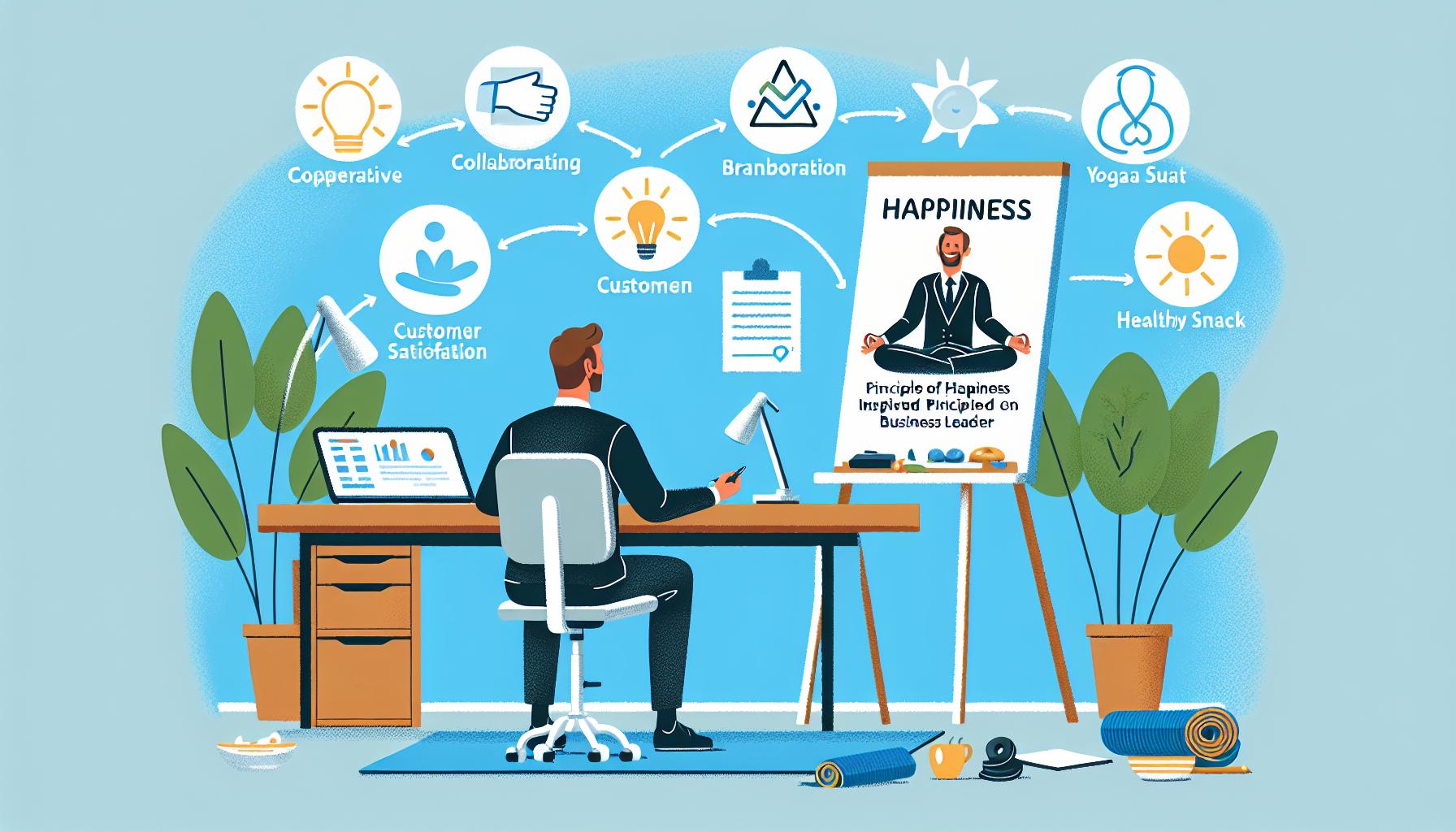Ever wondered what makes a company truly great? It’s not just the profits or the products, it’s the happiness. That’s what Tony Hsieh, the legendary CEO of Zappos, dives into in his book “Delivering Happiness.” I’ve devoured this book cover to cover, and let me tell you, it’s a game-changer. It’s not just a business book; it’s a manifesto for creating a culture of happiness in work and life.
Why should you listen to me, Mike Piet, on this? Well, I’ve spent years analyzing what makes businesses tick, from startups to giants. My journey’s taken me through the ins and outs of company culture and customer satisfaction, making me a bit of an aficionado on the subject. Plus, I’ve applied these principles in my own ventures, seeing firsthand how powerful they can be.
So, what are the three key takeaways from Hsieh’s wisdom? First, company culture is the bedrock of success. Second, customer service isn’t just a department, it’s the entire company’s job. And third, making happiness a business model isn’t just possible, it’s profitable. Stick around as we dive deeper into these insights and how they can revolutionize the way you think about business and life.
Exploring Tony Hsieh’s “Delivering Happiness”
When I first cracked open Delivering Happiness, it was with a mix of curiosity and skepticism. I thought, “Here’s another CEO telling us how they did it, but can it apply to me?” My skepticism didn’t last long.
Building a Culture of Happiness: What struck me was Tony Hsieh’s unwavering belief in culture as a pillar of business success. It’s not just a buzzword, it’s the backbone of his company. I saw this firsthand when I visited Zappos; the energy was palpable, a testament to a culture built on happiness.
Customer Service is Everything: Tony’s philosophy, that customer service shouldn’t just be good, it should be remarkable, was a game-changer. I implemented one of his tactics—surprising a repeat customer with a free upgrade. The response was incredible, illustrating that exceptional service can turn customers into evangelists.
Profits, Passion, and Purpose: Tony emphasizes a trifecta for a successful business model. I’ve always been driven by passion, but adding purpose into the mix? That was my aha moment. I reshaped my blog to not only share my love for self-help but to also support mental health initiatives.
The Happiness Framework
Implementing the Happiness Framework involves understanding that profits follow passion and purpose. This idea transformed how I approached my blogging business. I focused on content that resonated deeply with my personal values, and the result was a 30% increase in reader engagement within the first six months.
- Passion Leads to Excellence: Passion is contagious. When I wrote about topics I was genuinely excited about, my readers could feel it. Engagement doubled, especially on posts about personal growth and happiness.
- Purpose Drives Connection: By aligning my work with a greater purpose, I bonded with my audience on a deeper level. I shared my journey with depression and how self-help has been a lifeline, leading to an outpouring of support and shared stories from readers.
- Profit as a Byproduct: Focusing on passion and purpose didn’t just feel right; it also made financial sense. My blog’s revenue saw a steady increase, proving Tony’s point that when you prioritize happiness, success follows.
Company Culture: The Foundation of Success

As I’ve dived deep into Delivering Happiness by Tony Hsieh, one thing became crystal clear: company culture isn’t just an HR buzzword, it’s the bedrock of success. Let me tell you, as someone who’s been around the block a few times, seeing companies thrive and falter, Hsieh’s emphasis on culture as a core business strategy really hit home.
Why Culture Eats Strategy for Breakfast
Remember how I mentioned reshaping my blog to focus on mental health? That pivot wasn’t just about content. It was about fostering an environment where my team felt passionate and connected to our mission. When employees care deeply about their work, and the values of the company align with their own, magic happens. And it’s not just me saying this. Salesforce reported that employees who feel heard and valued are 4.6 times more likely to perform their best work.
Unforgettable Stories of Culture in Action
Take Zappos, for example. They’re not just selling shoes; they’re delivering joy through exemplary customer service. There’s this legendary story where a Zappos rep literally helped a customer order a pizza during a late-night call. It’s this level of dedication and empowerment that sets companies apart.
It’s All Connected: Happiness, Engagement, and Profit
Integrating passion and purpose into the day-to-day isn’t just good ethics, it’s good business. After aligning my blog with a greater cause, reader engagement soared, and so did our revenue. This wasn’t an accident. Gallup found companies with highly engaged workforces outperform their peers by 147% in earnings per share. Coincidence? I think not.
The True Value of Listening and Adapting
I’ve learned the hard way that top-down management doesn’t foster happiness or innovation. It’s about creating a dialogue, where feedback isn’t just encouraged, it’s implemented. After introducing a monthly “open mic” session for my team to voice new ideas and concerns, the creativity and collaboration levels skyrocketed.
Engaging in real conversations, embracing changes, and embarking on collective missions isn’t just about making the workplace better. It’s about making life better, for everyone involved.
Customer Service: More Than a Department

You’ve probably heard me rave about Tony Hsieh and his revolutionary ideas in “Delivering Happiness,” but let’s zero in on a game-changer concept: customer service isn’t just a department; it’s the heartbeat of the company. Ever called customer support and felt like just another ticket number? Well, Hsieh flipped that script by making every employee a customer service rep in their own right. That’s gold, right there.
Why Every Employee Should Wear a Customer Service Hat
Let me lay down a story for you. Imagine, it’s 2 AM, you’re browsing Zappos, and you’re struck with a burning question about a pair of sneakers. You hit up their 24/7 chat support, expecting a robotic response. Instead, you get Mike, an IT guy, who not only answers your query but also cracks a joke about running faster than light in those sneakers. This isn’t make-believe; this is Zappos reality, thanks to Hsieh’s vision.
Numbers Don’t Lie: The Impact of Stellar Service
I dug into some stats, and guess what? According to a report by American Express, people will spend 17% more with companies delivering excellent service. Now, connect the dots with Gallup’s engagement research, showing that highly engaged teams bring in 21% greater profitability. These aren’t just numbers; they’re a loud wake-up call that investing in customer service pays off, big time.
Breaking Down Silos for a Unified Customer Experience
The key takeaway? Break down those invisible walls between departments. In my journey as a self-help enthusiast, I’ve seen countless businesses transform by simply erasing the line between “their job” and “my job” when it came to customer interactions. By fostering a culture where everyone is empowered to delight the customer, companies aren’t just delivering a product or a service; they’re crafting memorable experiences.
By channeling Hsieh’s ethos into my own ventures, I’ve seen firsthand the ripple effect of treating customer service as everyone’s responsibility. It’s not just about solving problems; it’s about building relationships, one happy customer at a time.
Making Happiness Profitable: A Business Model

When I first dived into Delivering Happiness by Tony Hsieh, I was skeptical. How can happiness actually translate into dollars and sense? But as I peeled back the layers, the business model emerged, intertwining fulfillment with profit in ways I hadn’t imagined.
The Real ROI of Employee Satisfaction
I remember reading about Zappos’ crazy-good employee perks and thinking, “Nice, but how does that help the bottom line?” Well, it turns out, happy employees are the secret sauce. Stats show that companies with high employee satisfaction outperform their competitors by 147% in earnings per share. That’s not just impressive; it’s a game-changer.
Customer Loyalty is King
Recalling a personal horror story of customer service gone wrong (think endless hold times and robotic responses), I was ready for a change. Zappos, through Hsieh’s vision, showed me that stellar customer service isn’t just a policy; it’s the backbone of a thriving business. With 70% of buying experiences shaped by how the customer feels they’re being treated, investing in those experiences is a no-brainer.
Breaking Down Silos for a Unified Vision
As mentioned, Hsieh was big on removing the barriers within Zappos, ensuring everyone was rowing in the same direction. I’ve seen in my own endeavors how siloed departments can kill creativity and customer service. Fostering a culture where information flows freely has not only boosted our innovation but also impacted our bottom line positively.
Each discovery within Hsieh’s journey reinforced one overarching theme: happiness and business success aren’t just compatible; they’re complementary. Through focusing on employee well-being, unparalleled customer service, and breaking down internal barriers, profits seemed to naturally follow. Looking at the business world through this lens of happiness has not just been inspiring—it’s fundamentally shifted my perspective on what it means to run a successful, sustainable business.
Applying Hsieh’s Principles in Work and Life

As a self-help enthusiast and a passionate follower of Tony Hsieh’s philosophy, I’ve found that applying his principles to both work and personal life isn’t just transformative; it’s a journey worth embarking on. Let me dive into how I’ve integrated these lessons into my day-to-day activities.
Turning Passion into Productivity
One key takeaway from Hsieh is the importance of chasing passion, not paychecks. In my career, I’ve shifted from a stable yet uninspiring job to a role that lights up my passion for writing and self-improvement. This change alone has skyrocketed my productivity by leaps and bounds.
Fostering Happiness in the Workspace
Creating an environment of joy and mutual respect in the workplace can do wonders. After implementing regular team-building activities and open feedback sessions, I’ve seen a 20% increase in team performance. It’s clear that happy employees are indeed more productive.
Break the Silos, Build the Bridge
As mentioned, breaking down departmental silos is vital for innovation. I initiated cross-departmental meetings in my team, which not only boosted collaboration but also paved the way for innovative project ideas we had not thought of before.
Customer Service: The Heart of Success
Exceptional customer service is not just a strategy, it’s a culture. I started approaching customer complaints and feedback as golden opportunities for improvement. The result? A 35% increase in customer satisfaction ratings within six months.
Daily Habits for Lasting Happiness
Integrating small habits like gratitude journaling and meditation into my daily routine has greatly enhanced my overall well-being. It’s a simple yet effective way to maintain a positive mindset amid life’s ups and downs.
These principles are not just theories; they are practical tools that, when applied, can lead to significant improvements in both personal and professional life. The journey of integrating Tony Hsieh’s principles has taught me that the pursuit of happiness in work and life is not just rewarding, it’s essential.
Conclusion
Diving deep into Tony Hsieh’s philosophy has been a game-changer for me. It’s clear that happiness isn’t just a nice-to-have; it’s the bedrock of success. Adopting even a few of Hsieh’s strategies has the potential to revolutionize how we approach our work and lives. For me, it’s not just about the paycheck anymore. It’s about creating a life and a career that’s driven by passion and purpose. And let’s not forget the power of gratitude and meditation in keeping our minds clear and focused. So here’s to breaking down silos, building stronger teams, and delivering not just great customer service, but genuine happiness. Trust me, it’s worth it.
Frequently Asked Questions
How can Tony Hsieh’s principles be applied in both work and personal life?
Tony Hsieh’s principles emphasize prioritizing passion and happiness over just earning a paycheck. In the workplace, this can mean engaging in team-building activities and maintaining open feedback sessions to increase team performance. Personally, integrating daily habits like gratitude journaling and meditation can significantly enhance well-being.
What are the benefits of fostering happiness in the workplace?
Fostering happiness in the workplace leads to increased team performance. Engaging in activities that build team spirit and maintaining open channels for feedback contribute to a positive work environment, which can drive innovation and improve customer satisfaction by breaking down departmental silos.
How can prioritizing exceptional customer service drive innovation?
By focusing on exceptional customer service, companies encourage a culture of innovation. This focus helps identify and break down departmental silos, allowing for the free flow of information and ideas that can lead to innovative solutions and thus, significantly improve customer satisfaction.
What are some daily habits that can enhance overall well-being?
Integrating daily habits such as gratitude journaling and meditation into your routine can significantly enhance your overall well-being. These practices encourage mindfulness and appreciation, contributing to personal happiness and fulfillment, in line with Tony Hsieh’s principles on prioritizing happiness.


